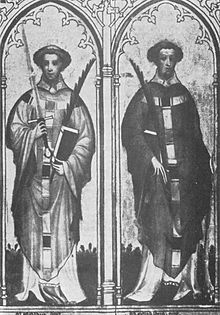Two Ewalds
Sts Ewald the Black and Ewald the Fair | |
|---|---|
 Painting of the pair on the Ewaldi-Reliquienschrein at the Church of Saint Kunibert, Cologne, c. 1400 | |
| Martyr | |
| Died | c.692[1] |
| Feast | October 3 |
| Patronage | Westphalia |
The Two Ewalds (or Two Hewalds) were Saint Ewald the Black and Saint Ewald the White,
Background
The two priests were companions, both natives of Northumbria, England. According to the example of many at that time, they spent several years as students in the schools of Ireland. Ewald the Black was the more learned of the two, but both were equally renowned for holiness of life. They were apparently acquainted with St. Willibrord, the Apostle of Friesland, and were animated with his zeal for the conversion of the Germans. Some sources number them among the eleven companions of that saint.[2] More probably, however, they set out from England after St. Willibrord's departure, in an attempt to convert their own cousins in Old Saxony.
They entered upon their mission about 690. The scene of their labours was the country of the ancient
The pagan Saxons, witnessing these activities of the Christian priests and missionaries, began to suspect that the Ewalds planned to convert their over-lord, destroy their temples and supplant their religion. Inflamed with jealousy and anger, they resolved that the Ewalds should die. An uprising followed and both priests were quickly seized. Ewald the Fair was killed quickly by sword; Ewald the Black was tortured and torn limb from limb, after which both their bodies were cast into the Rhine. This is understood to have happened on 3 October at a place called Aplerbeck, today a district of Dortmund, where a chapel still stands. When the ealdorman heard of what had been done, he became angry and fearful of reprisals, and punished the murderers by putting them to death and burning their villages.[2]

Christian sources describe various
Until the martyrdom of Saint Boniface in 754, the Ewalds were the last missionaries to be martyred in this area. Their deaths were undoubtedly due to a lack of support from the worldly rulers: "Ohne den fränkischen Schutz lebte ein Missionär nicht lange genug, um seine Lehre genauer zu erläutern," ("Without the Franconian protection, a missionary did not live long enough to explain his teaching more closely") according to Franz Staab.[1]
Druten, in the east of the Netherlands, has a church dedicated to the Ewalds, with statues for the two made in the studio Atelier Cuypers-Stoltzenberg, owned by Pierre Cuypers and F. Stoltzenberg.[3]
See also
- Ewald Saints, patron saint archive
References
- ^ a b Staab, Franz (1988). "Die Gründung der Bistümer Erfurt, Büraburg und Würzburg durch Bonifatius im Rahmen der Fränkischen und Päpstlichen Politik". Archiv für Mittelrheinische Kirchengeschichte. 40: 13–41, pp. 36-37.
- ^ a b c d e f
 One or more of the preceding sentences incorporates text from a publication now in the public domain: Edmonds, Columba (1909). "Sts. Ewald". In Herbermann, Charles (ed.). Catholic Encyclopedia. Vol. 5. New York: Robert Appleton Company.
One or more of the preceding sentences incorporates text from a publication now in the public domain: Edmonds, Columba (1909). "Sts. Ewald". In Herbermann, Charles (ed.). Catholic Encyclopedia. Vol. 5. New York: Robert Appleton Company.
- ^ Geloof in Nederland: 2000 jaar Nederlanders en hun kerstening (in Dutch). Vol. 12. Utrecht: Waanders/Museum Catharijneconvent. p. 377.
- Stock, Eugene; et al. (1911). . In Chisholm, Hugh (ed.). Encyclopædia Britannica. Vol. 18 (11th ed.). Cambridge University Press. p. 584.
